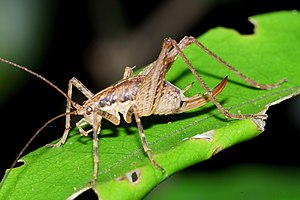Neonetus
| Neonetus | |
|---|---|

| |
| Neonetus variegatus | |
| Scientific classification | |
| Kingdom: | Animalia |
| Phylum: | Arthropoda |
| Class: | Insecta |
| Order: | Orthoptera |
| Suborder: | Ensifera |
| Family: | Rhaphidophoridae |
| Subfamily: | Macropathinae |
| Genus: | Neonetus Brunner von Wattenwyl, 1888 |
| Species | |
|
See text. | |
Neonetus is a genus of cave wētā in the family Rhaphidophoridae, endemic to New Zealand. All described species are small; when adult, individuals are only about 1 cm long.[1] Neonetus variegatus and N. huttoni are common in native and exotic forests but because they are small and nocturnal, they are often overlooked.[2]
Neonetus are small cave wētā that inhabit forest, especially among the damp litter and decaying logs, sometime in damp tree holes. The genus has been overlooked due to its small size and cryptic nature, and additional species are likely to exist.[3] Colour patterns appear to be variable even within populations and between males and females and between adults and juveniles, adding to taxonomic confusion.[1] Some forms carry a prominent pale longitudinal stripe and have been referred to as the "painted" weta. However, similar colour pattern variation exists in Isoplectron.[4]
Taxonomy
This section is empty. You can help by adding to it. (September 2022) |
The genus Neonetus was established by Brunner von Wattenwyl in 1888.
Morphology
Neonetus variegatus [4]
Body length: 11-16mm.[5] Pronotum: 3mm. Ovipositor: 6.5mm.
Antennae: “about three times the length of the body” = 36mm. Legs: posterior femora 9.5mm., posterior tibia 11.5mm
Male subgenital plate highly modified with large central curving ridge,[5] female subgenital plate small notched or lobed triangle[6]
Neonetus pilosus[7]
Body length: 11mm. Antennae: “very hairy”. Pronotum 4mm. Thorax 7mm.
Abdomen 5mm. Width at mesonotum 4 mm.
Legs: Very hairy. Fore tibia 6mm. Hind tibia 11 mm. Hind femur 10 mm.
Biology
This section is empty. You can help by adding to it. (September 2022) |
Neonetus are active at night when they are vulnerable to becoming food for rats[8] and kiwi.[9]
Distribution
Disturbed environments appear not to impede the distribution of Neonetus variegatus, and pine forest appears to provide a valuable habitat for at least some endemic invertebrates.[1]
Current observational data suggests that Neonetus is restricted to the North Island of New Zealand.[10]
Neonetus variegatus is abundant across all three habitats (pine forest, native forest and shrubland) throughout the year, but appears to be more abundant in pine forest than native forest and shrubland.[1]
Species
- Neonetus huttoni Chopard, 1923
- Neonetus pilosus (Hutton, 1904)
- Talitropsis/Neonetus poduroides (Walker, 1869)
- Neonetus variegatus Brunner, 1888
References
- ^ a b c d Fitness, J. L.; Morgan-Richards, M.; Ball, OJ-P.; Godfrey, A. J. R.; Trewick, S. A. (2015). "Improved resolution of cave weta diversity (Orthoptera: Rhaphidophoridae): ecological implications for Te Paki, Far North, New Zealand". New Zealand Journal of Zoology. 42 (1): 1–16. doi:10.1080/03014223.2014.983939. ISSN 0301-4223. S2CID 55361809.
- ^ Trewick, Steve (2019). Wild life New Zealand. Morgan-Richards, Mary (2nd ed.). [Palmerston North]: Hand-in-hand Press. ISBN 9780473483203. OCLC 1115003436.
- ^ Farnworth, Bridgette; Innes, John; Kelly, Catherine; Littler, Ray; Waas, Joseph R. (2018). "Photons and foraging: Artificial light at night generates avoidance behaviour in male, but not female, New Zealand weta". Environmental Pollution. 236: 82–90. doi:10.1016/j.envpol.2018.01.039. ISSN 0269-7491.
- ^ a b "Neonetus". wetageta.massey.ac.nz. Retrieved 8 September 2022.
- ^ a b Johns, P. M.; Cook, L. D. (2013). "Maotoweta virescens new genus and new species; hidden in a moss forest (Orthoptera: Rhaphidophoridae)". Records of the Canterbury Museum. 27: 11–17.
- ^ F., Ward, Darren (1997). "A new generic key to the New Zealand cave weta genera (Orthoptera: Rhaphidophoridae". doi:10.26021/485.
{{cite journal}}: Cite journal requires|journal=(help) - ^ Morgan-Richards, Mary (January 1995). "A new species of tree weta from the North Island of New Zealand (HemideinaStenopelmatidae: Orthoptera)". New Zealand Entomologist. 18 (1): 15–23. doi:10.1080/00779962.1995.9721996. ISSN 0077-9962.
- ^ MOORS, P. J. (1985). "NORWAY RATS (RATTUS NORVEGICUS) ON THE NOISES AND MOTUKAWAO ISLANDS, HAURAKI GULF, NEW ZEALAND". New Zealand Journal of Ecology. 8: 37–54. ISSN 0110-6465.
- ^ Colbourne, Rogan; Baird, Karen; Jolly, Jim (1990). "Relationship between invertebrates eaten by little spotted kiwi, Apteryx owenii, and their availability on Kapiti Island, New Zealand". New Zealand Journal of Zoology. 17 (4): 533–542. doi:10.1080/03014223.1990.10422951. ISSN 0301-4223.
- ^ "iNaturalist". iNaturalist. Retrieved 8 September 2022.
- PeripatusError: "Q6993515" is not a valid Wikidata entity ID.
- CS1 errors: missing periodical
- Use dmy dates from September 2022
- Articles with short description
- Articles with 'species' microformats
- Articles to be expanded from September 2022
- All articles to be expanded
- Articles with empty sections from September 2022
- All articles with empty sections
- Articles using small message boxes
- Incomplete lists from August 2008
- Taxonbars desynced from Wikidata
- Taxonbar pages requiring a Wikidata item
- Taxonbars with invalid from parameters
- Taxonbars without secondary Wikidata taxon IDs
- Ensifera genera
- Cave weta
